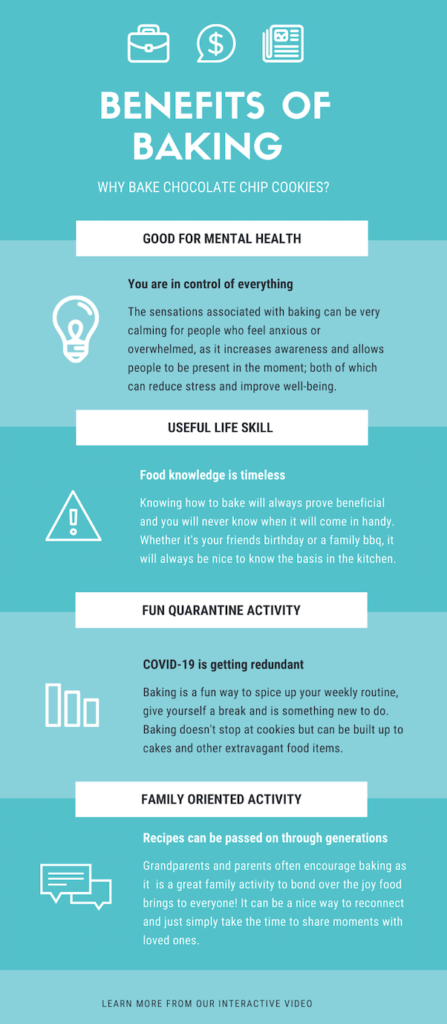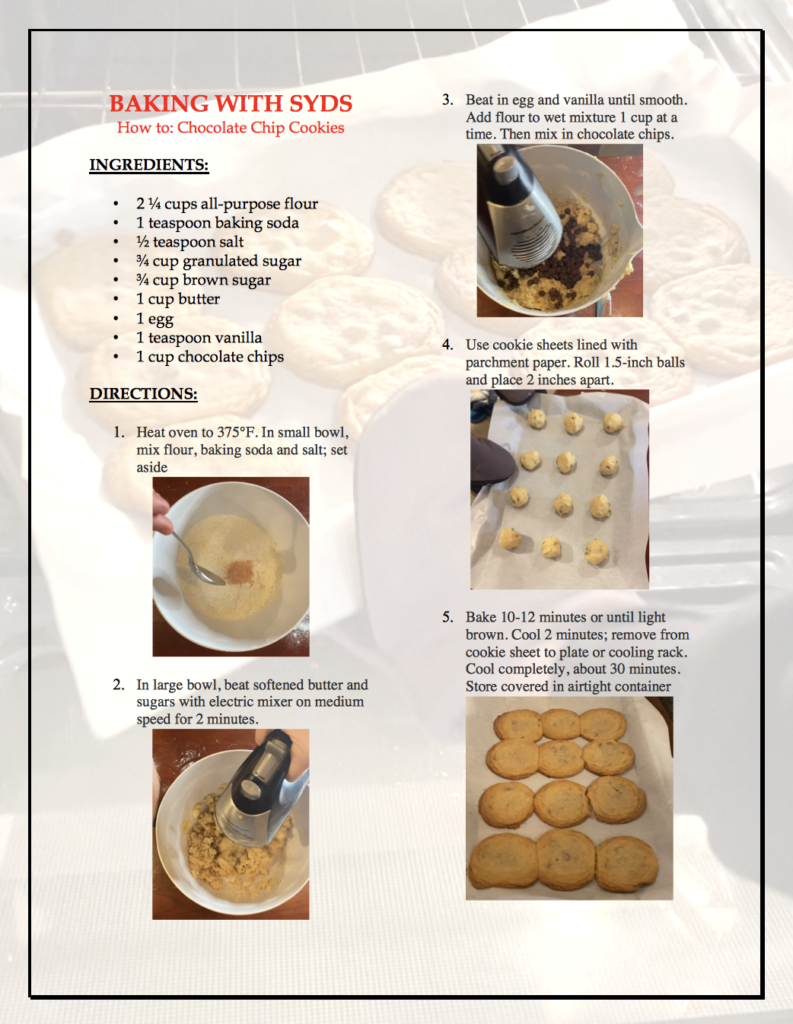Multimedia Lesson Plan: Baking Chocolate Chip Cookies
Goal
Learners will be able to execute the recipe for chocolate chip cookies, which will enhance their basic techniques and understanding of the importance of baking.
Learning Objectives
By then end of the lesson, learners will be able to:
- Exhibit the use of sanitation and safety practices in baking production.
- Describe the use of equipment, tools, and utensils commonly used in bakery production.
- Explain procedures for measuring wet and dry ingredients.
- Demonstrate proficiency in the usage of standardized recipes.
- Prepare chocolate chip cookies.
- Bake and cool cookies correctly.
Prior Knowledge
- Learners will need to know how to follow simple recipe instructions.
- Learners will need to be familiar with oven uses including the baking function, preheating the oven, and temperature.
Delivery
- Introduce the chocolate chip cookie recipe and tell a personal story to illustrate why baking is an important life skill.
- Verbal and text instructions
- Overview of sanitization/safety protocols and introductory recipe steps.
- Verbal and text instructions
- Video worked examples
- Video with H5P multiple-choice questions for formative assessment
- Gather and measure designated ingredients.
- Verbal and text instructions
- Video worked examples
- Combine dry and wet ingredients separately. Then add them together.
- Verbal and text instructions
- Video worked examples
- Video with H5P multiple-choice questions for formative assessment
- Roll dough into balls and drop them onto cookie sheet.
- Verbal and text instructions
- Video worked examples
- Video with H5P multiple-choice questions for formative assessment
- Bake cookies and explain proper baking, cooling and storage procedures.
- Verbal and text instructions
- Video worked examples
- Video with H5P multiple-choice questions for formative assessment
Evaluation
- Learners will follow designated baking times but also colour test the cookies. Golden brown will indicate they are finished.
- Learners will evaluate the taste of the cookies by eating them.
To grab the attention of the learners, an infographic explains the life benefits of baking. The interactive video with included PowerPoint slides then fully explains how to properly execute the recipe. The Baking with Syds cheat-sheet recipe allows easy reference to the baking instructions with progress pictures attached for comparison.
The multimedia learning principle incorporates a combination of words, videos and narration. This is much more effective than just words alone and provides the learners with multiple ways of absorbing content.
Worked examples principle was followed as we personally demonstrated the proper methods through video clips or pictures of us preforming the tasks we were explaining. This helps the audience think of the lesson in a practical and meaningful way.
The segmenting principle incorporated multiple-choice questions after important steps in the recipe. We used PowerPoint slides to divide the recipe into learner-paced segments, followed by short video clips with narration. In the cheat-sheet recipe, segments were created with numbered bullet points. Coloured and titled sections were also created in the infographic. This allows learners to develop a strong understanding of each concept, before moving onto the next steps.
The personalization principle was used because our video was presented in a conversational style, where we began with a personal experience of baking with family members, others can relate to. Narration made people feel involved and emotionally invested in the material, allowing learners to pay closer attention to the content. This principle was also used in the infographic by explaining the benefits of baking to enhance the learner’s personal life.
The feedback principle was also used where after each multiple-choice question, feedback was provided if the learner got the question wrong. This allows for active learning because it engaged the leaners through hands-on skill building.
Avoiding “Death by PowerPoint,” the cognitive load theory was used to ensure that only one idea was discussed and there were no more than six bullet points per PowerPoint slide. We avoided reading off the text from our slides and instead let the audience read the information (redundancy principle). The slides told a step-by-step story that the audience could follow. This helped us to avoid overloading the working memory before time for encoding.
The dual coding theory was used in the interactive video by incorporating narration to each video clip because combining information from visual and verbal channels allows learners to remember more. We avoided overloading the visual channel by limiting the amount of text and images that explained the same concept.
Behaviourism and the concept of flow kept the audience engaged. Videos, images and narration enhanced engagement because visually seeing the task allows learners to actively learn the steps, developing a deeper understanding and cultivating passion. The multiple-choice questions were intrinsically rewarding and personal life benefits developed connections, increasing motivation.

